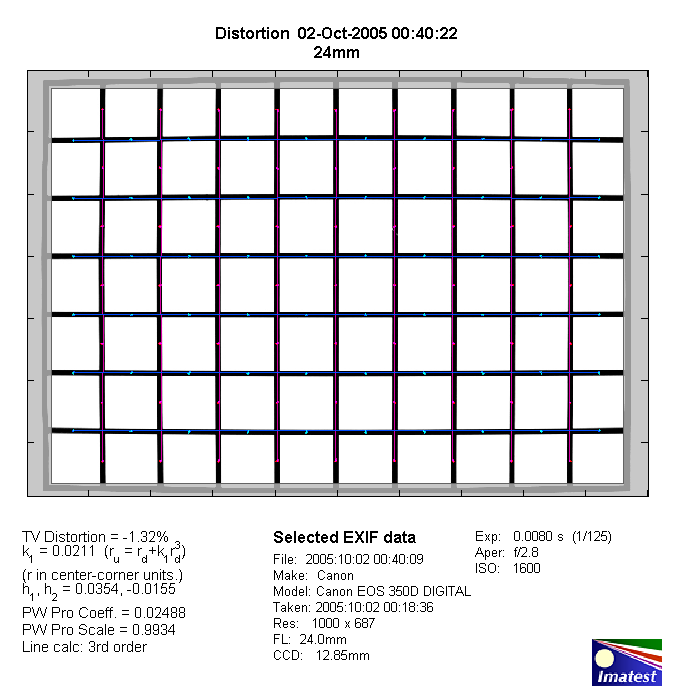|
Canon EF 24mm f/2.8 - Review / Test Report - Analysis |
|
Lens Reviews -
Canon EOS (APS-C)
|
|
Page 2 of 3

Distortion
The lens showed some slight barrel distortion but usually it isn't something to worry about.

The chart above has a real-world size of about 120x80cm.
Vignetting
On the EOS 350D with its reduced format (APS-C) the (full format) lens exhibits quite
pronounced vignetting at wide-open aperture which is a little surprising for a full format
lens. However, from f/4 & up the problem is quite negligible.

MTF (resolution)
When looking at the MTF chart below you may come to the conclusion that the lens is a
superb performer. Usually this is also correct with an excellent center
and border performance at all tested aperture settings (at very small aperture
settings there'll be the usual diffraction effects naturally).
However, it is worth to notice that the lens showed a rather unusual behavior in the lab - during
the initial tests the performance dropped from f/2.8 to f/4 without improving till f/8. Quite
bizarre (normally the focus distance at (~60x focal-length) remains untouched during a test across
the aperture range). Upon discussing the effect in the local forum (thanks, Joachim!) one explanation
for this may be that the focus point moves slightly dependent on the aperture (residual spherical
aberration). Usually this is nothing to worry about because the increased depth-of-field hides these
minor focus effects. However, it seems as if this focus shift is more pronounced with this lens.
So is this behavior field relevant ? Yesno. You will not see any effect e.g. in landscape
shots but you may experience slight focus errors at closer focus distances (at least at the
used test distance of ~1.5m). In manual focusing mode you focus at working aperture (f/2.8)
and when choosing a medium aperture you'll ultimately run into this situation - it's a good
idea to take advantage of the depth-of-field preview here.
The AF -may- take advantage of the lens ROM which should contain the corresponding data about the
optimal focus point in order to choose a focus compromise. It is unknown whether and/or how
EOS cameras are applying corrections here and the specific AF behavior of the test camera
is meaningless statistically.
The chart below reflects the optimal performance obtained at slightly different focus
settings across the aperture range (which is actually a non-standard test method here).
Please note that the MTF results are not directly comparable across the different systems!
Below is a simplified summary of the formal findings. The chart shows line widths per picture height (LW/PH) which can be taken as a measure for sharpness.
If you want to know more about the MTF50 figures you may check out the corresponding Imatest Explanations
Chromatic Aberrations (CAs)
CAs are quite well under control with this lens with an average CA pixel width at the image borders below 1 pixel.
However, it's not a very special performance either.

|